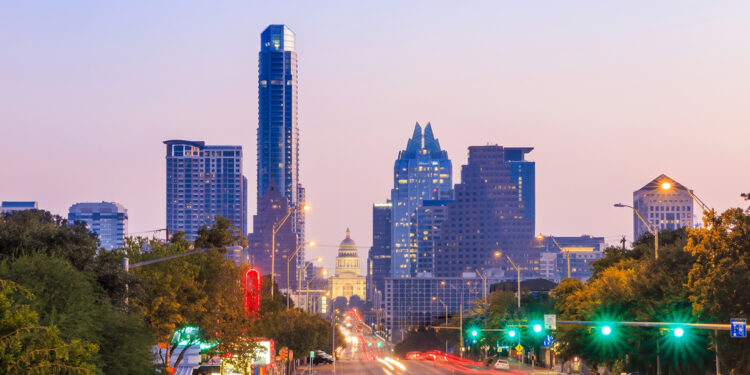Laura Huffman, president of the Austin Chamber of Commerce, explains how Austin became one of two US cities to beat the COVID-19 pandemic and achieve economic growth in 2020.
—
WHEN AUSTIN’S MOONLIGHT towers blinked on for the first time in 1895 as a beacon of modernity in the newly electrified United States, citizens took it as a sign of civic confidence in a bright future. Judging from last year’s news that confidence seems justified. In 2021 Austin brought in billion-dollar investments from tech giants Tesla and Samsung and beat a seemingly unstoppable global economic downturn.
The Austin Chamber of Commerce has been riding shotgun on this city’s remarkable drive to success during a period of widespread upheaval.
“When I started this job two years ago there was global concern whether or not this pandemic was going to create huge job losses and a huge down-turn,” says Laura Huffman, President and CEO of the Austin Chamber of Commerce. “There were a lot of question marks.”
But as the COVID-19 pandemic wreaked economic havoc, Austin proved to have one of the most resilient economies in the United States. Only one other major metro area, San José, California, saw GDP growth in 2020.
“One thing I find telling about the success of Austin’s economy is that at arguably one of the most uncertain times in modern history, the resilience of our economy and the fundamentals that produce that economy show the strategies that we have been working on for two decades are paying off in spades,” adds Huffman.
Austin’s economic growth in 2020 was spearheaded by the financial services industry, which grew by 9% in 2020 and accounts for 19.3% of local GDP. Professional and business services account for 17.3% of local GDP. But the pandemic years also saw Austin attracting world-class companies.
In December 2021 vanguard electric vehicle manufacturer Tesla decided to move its headquarters to Austin where it was already building a $1.1 billion dollar manufacturing facility that broke ground in 2020. In 2021 Samsung announced it would be investing $17 billion in a new semiconductor manufacturing facility.
“Samsung has been present in the community for decades but the fact that it is reinvesting and remitting to making the world’s most modern technology just further cements Austin’s reputation as a tech hub,” notes Huffman. “But we also had a lot of interesting start-up successes. We had some home runs in 2020 and 2021 but historically, the economy just really accelerated. Very quickly most of the jobs that were lost at the beginning of the pandemic were regained.”
According to the US Bureau of Labor Statistics, the Austin metro area saw the sixth-highest year-over-year increase in employment in the United States at 7.3% in February, after Las Vegas and Orlando.
With this economic success has come explosive physical growth. Hays County of which Austin is a part the highest percentage change in the number of housing units, growing housing by 57% between 2010 and 2020 as part of a cohort of five Texas counties among the 10 fastest-growing housing markets in the United States.
“We operate off a very strong strategic plan, so I think that what we can expect to see in the short term is continued growth in advanced manufacturing and automobile manufacturing,” says the University of Texas at Austin grad Huffman. “Approximately 10,000 jobs will be associated with Tesla’s giga-factory in Austin. There are now an enormous number of opportunities in the Central Texas Region.”
Austin has several factors pulling businesses in, such as a low cost of living and no state income tax, as well as a few outstanding economic clusters. For example, in the case of automobile manufacturing and Tesla, for every direct job at Tesla four to six indirect jobs are created in areas such as supply chains and construction.
“What is bringing people to Austin are the economic anchors we have in the technology industry, such as advanced manufacturing, life sciences, fintech, and automobile manufacturing,” says Huffman. “What is interesting about Austin’s economic strategy is that it is very intentional. When companies seek to relocate to this region they see supply chains, they see talent, they see quality of life. They see an eco-system of business they are either customers of or who will become their customers.”
The capital city of Texas, Austin has a cultural range belying its economic success with festivals from blockbuster South-by-Southwest SXSW to the avant-garde No Idea Festival. Big-name musicians such as Willie Nelson and Stevie Ray Vaughan contributed to the city’s cultural legend. Now, this happening vibe has contributed to the attraction of corporate offices of cutting-edge companies such as Google, Meta, Apple, Amazon, IBM, Intel, and Tesla to the 2.3 million inhabitants strong metro area.
Before joining the Austin Chamber of Commerce, Huffman was the founding director of the Urban Strategies in North America program for the Nature Conservancy where she spent twelve years.
“There were two big things about this opportunity which were attractive to me,” adds Huffman. “One is that the chamber is centered on building a dynamic regional economy. An economy that is resilient for everything from financial downturns, to natural disasters, to a pandemic, an economy, which is very intentional about the kind of businesses that we want to grow. Secondly, I was interested in the opportunity for the chamber to play a role in those fundamental issues on which a strong, resilient, economy and a healthy community depend.”
Quality of life, force development, and infrastructure are other long-term fundamentals through which the chamber has formulated its regional strategies. Another driver of Austin’s success has been its education system characterized by the powerhouse presence of the University of Texas at Austin.
“One thing working beautifully for this region is our education system,” adds Huffman. “The care with which they look at the economy they look into the future, they think about the programs they are offering students is incredible. Our community college works directly with Tesla to identify programs that they could initiate to develop workers for those technology jobs.”
The University of Texas at Austin’s high-ranking programs in aerospace, petroleum engineering, biomedicine, computer science, and business programs underlie Austin’s increasing success as an innovation hub.
“I think this combination of paying close attention to talent and how we prepare talent for the jobs that are coming to Austin, as well as how we reskill people who may have been coming out of jobs that weren’t coming back, says a lot not only about Austin’s economy but also its spirit,” adds Huffman.
(Courtesy Austin Chamber of Commerce. By Joe Banner)












